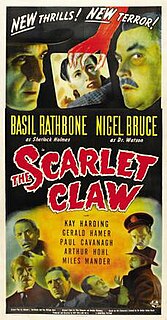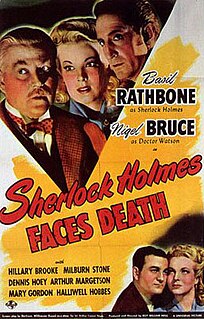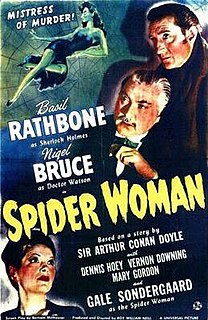 W
WThe Adventures of Sherlock Holmes and Dr. Watson is a 1980 Soviet film adaptation of Arthur Conan Doyle's stories about Sherlock Holmes. It is the second film in The Adventures of Sherlock Holmes and Dr. Watson film series directed by Igor Maslennikov.
 W
WThe Adventures of Sherlock Holmes is a 1939 mystery-adventure film released by Twentieth Century Fox. It is a pastiche featuring the characters of the Sherlock Holmes series of books written by Sir Arthur Conan Doyle. The film credits the 1899 play, Sherlock Holmes by William Gillette as the source material for the movie script, though there is little resemblance in the plots.
 W
WThe House of Fear is a 1945 crime film directed by Roy William Neill. It is loosely based on the 1891 short story "The Five Orange Pips" by Arthur Conan Doyle, and features the characters Sherlock Holmes and Dr. Watson. It is the 10th film of the Rathbone/Bruce series.
 W
WThe Pearl of Death is a 1944 Sherlock Holmes film starring Basil Rathbone as Holmes and Nigel Bruce as Dr. Watson, the ninth of fourteen such films the pair made. The story is loosely based on Conan Doyle's short story "The Adventure of the Six Napoleons" but features some additions, such as Evelyn Ankers as an accomplice of the villain, played by Miles Mander, and Rondo Hatton as a brutal killer.
 W
WThe Return of Sherlock Holmes is a 1929 American Pre-Code mystery film directed by Basil Dean and written by Arthur Conan Doyle, Basil Dean and Garrett Fort. The film shares its title with the third volume of the Sherlock Holmes stories, The Return of Sherlock Holmes by Arthur Conan Doyle. The film stars Clive Brook, H. Reeves-Smith, Betty Lawford, Charles Hay and Phillips Holmes. The film was released October 29, 1929, by Paramount Pictures. A copy is held at the Library of Congress.
 W
WThe Scarlet Claw is a 1944 Sherlock Holmes film directed by Roy William Neill and starring Basil Rathbone and Nigel Bruce. It is the eighth film of the Rathbone/Bruce series. David Stuart Davies notes on the film's DVD audio commentary that it's generally considered by critics and fans of the series to be the best of the twelve Holmes films made by Universal.
 W
WSherlock is a British crime television series based on Sir Arthur Conan Doyle's Sherlock Holmes detective stories. Created by Steven Moffat and Mark Gatiss, it stars Benedict Cumberbatch as Sherlock Holmes and Martin Freeman as Doctor John Watson. 13 episodes have been produced, with four three-part series airing from 2010 to 2017, and a special episode that aired on 1 January 2016. The series is set in the present day, while the one-off special features a Victorian period fantasy resembling the original Holmes stories. Sherlock is produced by the British network BBC, along with Hartswood Films, with Moffat, Gatiss, Sue Vertue and Rebecca Eaton serving as executive producers. The series is supported by the American station WGBH-TV Boston for its Masterpiece anthology series on PBS, where it also airs in the United States. The series is primarily filmed in Cardiff, Wales, with North Gower Street in London used for exterior shots of Holmes and Watson's 221B Baker Street residence.
 W
WSherlock Holmes is a Russian television crime drama series based on the Sherlock Holmes detective stories by Arthur Conan Doyle, and was aired in November 2013. Some of the stories have never been adapted before. It stars Igor Petrenko as Sherlock Holmes and Andrei Panin as Doctor John Watson. Eight episodes have been produced, while the first episode was aired in late 2013.
 W
WSherlock Holmes and the Secret Weapon (1942) is the fourth in the Basil Rathbone/Nigel Bruce series of 14 Sherlock Holmes films which updated the characters created by Sir Arthur Conan Doyle to the then present day. The film is credited as an adaptation of Conan Doyle's 1903 short story "The Adventure of the Dancing Men," though the only element from the source material is the dancing men code. Rather, it is a spy film taking place on the background of the then ongoing Second World War with an original premise. The film concerns the kidnapping of a Swiss scientist by their nemesis Professor Moriarty, to steal a new bomb sight and sell it to Nazi Germany. Sherlock Holmes and Dr. John Watson have to crack a secret code in order to save the country. The film is one of four films in the series which are in the public domain.
 W
WSherlock Holmes and the Voice of Terror is the third film in the Basil Rathbone/Nigel Bruce series of Sherlock Holmes movies and the first to be produced by Universal Pictures. Made in 1942, the film combines elements of the 1917 Arthur Conan Doyle story "His Last Bow", to which it is credited as an adaptation, and loosely parallels the real-life activities of Lord Haw-haw. Horror film "scream queen" Evelyn Ankers appears as leading lady.
 W
WSherlock Holmes Faces Death is the sixth film in the Basil Rathbone/Nigel Bruce series of Sherlock Holmes films. Made in 1943, it is a loose adaptation of Sir Arthur Conan Doyle's Holmes 1893 story "The Adventure of the Musgrave Ritual." Its three immediate predecessors in the film series were World War II spy adventures with Holmes and Dr. Watson as characters, but this one marks a return to the pure mystery film form. Though several characters are military men and there are frequent mentions of the war, it is not the focus of the story.
 W
WThe Sign of Four is a 1932 British crime film directed by Graham Cutts and starring Arthur Wontner, Ian Hunter and Graham Soutten. The film is based on Arthur Conan Doyle's second Sherlock Holmes novel The Sign of the Four (1890). The film is also known as The Sign of Four: Sherlock Holmes' Greatest Case.
 W
WThe Sign of Four is a 1983 British made-for-television mystery film directed by Desmond Davis and starring Ian Richardson and David Healy. The film is based on Sir Arthur Conan Doyle's 1890 novel of the same name, the second novel to feature Sherlock Holmes and Doctor Watson.
 W
WThe Speckled Band is a 1931 British film directed by Jack Raymond and an adaptation of Arthur Conan Doyle's original 1892 story "The Adventure of the Speckled Band" and the 1910 play he adapted from it, The Speckled Band.
 W
WThe Spider Woman is a 1943 mystery film starring Basil Rathbone as Sherlock Holmes and Nigel Bruce as Dr. Watson, the seventh of fourteen such films the pair were involved in. As with all of the Universal Studios films in the series, the film is set in then-present day as opposed to the Victorian setting of the original stories. This film incorporates elements from the novel The Sign of the Four, as well as the short stories "The Final Problem", "The Adventure of the Empty House", "The Adventure of the Speckled Band" and makes explicit reference to "The Adventure of the Devil's Foot".
 W
WA Study in Scarlet is a 1914 American silent film directed by and starring Francis Ford as Sherlock Holmes. It is believed that Ford's younger brother, John Ford, portrayed Dr. Watson. It is based on the Sir Arthur Conan Doyle 1887 novel of the same name
 W
WA Study in Scarlet is a 1933 American Pre-Code mystery thriller film directed by Edwin L. Marin and starring Reginald Owen as Sherlock Holmes and Anna May Wong as Mrs. Pyke. The title comes from Arthur Conan Doyle's 1887 novel of the same name, the first in the Holmes series, but the screenplay by Robert Florey was original.
 W
WTerror by Night is a 1946 Sherlock Holmes crime drama directed by Roy William Neill and starring Basil Rathbone and Nigel Bruce. The story revolves around the theft of a famous diamond aboard a train. It is one of four films in the series in the public domain.
 W
WThe Triumph of Sherlock Holmes is a 1935 British mystery film directed by Leslie S. Hiscott and starring Arthur Wontner. It was based on the 1915 Sherlock Holmes novel The Valley of Fear by Arthur Conan Doyle.
 W
WThe Twentieth Century Approaches is a 1986 Soviet film adaptation of Arthur Conan Doyle's stories about Sherlock Holmes. It is the fifth and final film in The Adventures of Sherlock Holmes and Dr. Watson film series directed by Igor Maslennikov.
 W
WThe Woman in Green is a 1945 American film, the eleventh of the fourteen Sherlock Holmes films based on the characters created by Arthur Conan Doyle. Directed by Roy William Neill, it stars Basil Rathbone as Sherlock Holmes and Nigel Bruce as Dr. Watson, with Hillary Brooke as the woman of the title and Henry Daniell as Professor Moriarty. The film follows an original premise with material taken from "The Final Problem" (1893) and "The Adventure of the Empty House" (1903).